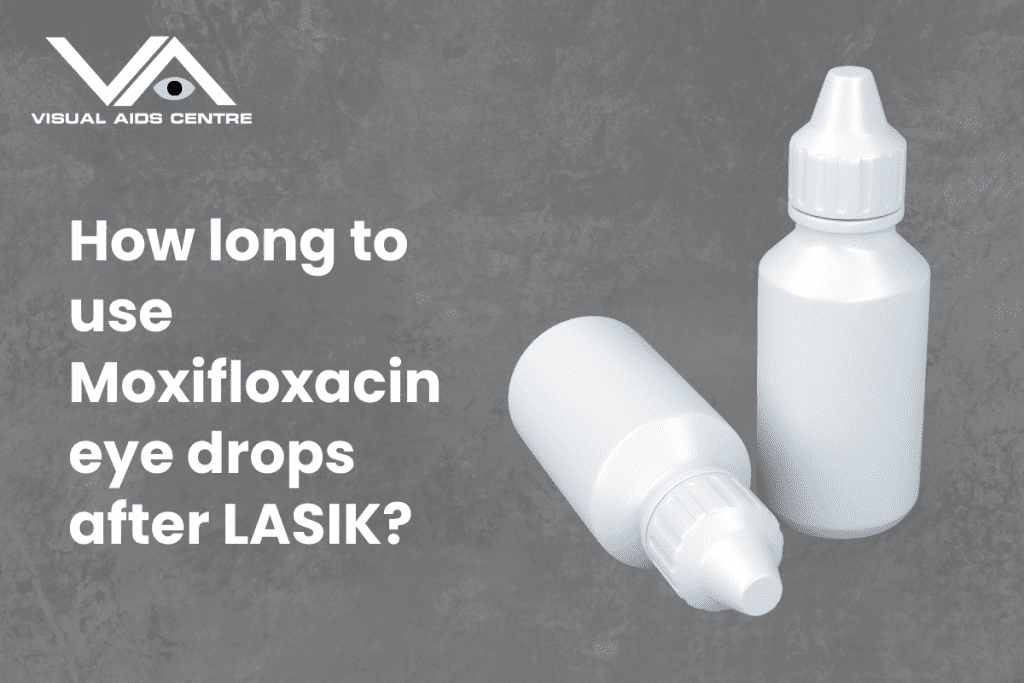Table of Contents
ToggleYou will typically need to use Moxifloxacin eye drops for about 7-10 days following LASIK surgery to help prevent infection.
However, the exact duration may vary based on your surgeon’s recommendation and your recovery process.

Why Are Moxifloxacin Eye Drops Used After LASIK?
LASIK, or laser-assisted in situ keratomileusis, is a widely performed eye surgery to correct refractive errors such as nearsightedness, farsightedness, and astigmatism. While it’s a commonly safe and highly effective procedure, post-operative care plays a crucial role in ensuring a smooth recovery.
Moxifloxacin, an antibiotic eye drop, is a critical part of this care. Its primary function is to prevent bacterial infections that could potentially interfere with your recovery or compromise the success of the surgery. The corneal flap created during LASIK makes the eye temporarily more vulnerable to infections. Moxifloxacin helps shield your eyes from harmful bacteria during this critical healing phase.
How Long Should You Use Moxifloxacin Eye Drops After LASIK?
The Standard Protocol
Patients are generally advised to use Moxifloxacin drops for 7 to 10 days post-surgery, as this is typically long enough to mitigate the risk of infection during the early stages of healing.
Your doctor will provide specific instructions tailored to your recovery. It is common practice to apply one drop to the affected eye(s) four times a day or as directed by your ophthalmologist. This means morning, mid-day, evening, and before bed.
Individual Recovery Factors
Although 7-10 days is the standard, the duration may vary based on individual cases. Factors such as the patient’s overall eye health, the complexity of the LASIK procedure performed, and how well your cornea is healing can all influence the timeline. Some patients may be prescribed the drops for an extended period, especially if the surgeon identifies additional risk factors for infection.
Always Follow Your Doctor’s Advice
It is vital to strictly adhere to the schedule provided by your eye surgeon. Even if your vision feels perfect a few days after LASIK, stopping the drops too soon can increase the risk of complications. Conversely, continuing use beyond the prescribed period without consulting your doctor may lead to unnecessary side effects or antibiotic resistance.
Step-by-Step Guidance for Using Moxifloxacin Drops
1. Clean Hands First
Wash your hands thoroughly to avoid introducing bacteria into your eye.
2. Positioning
Tilt your head backwards or lay down flat while applying the drops.
3. Pull Down Your Lower Eyelid
Carefully lower the bottom eyelid to form a small pocket.
4. Apply One Drop
Hold the dropper close to your eye without touching your eyelid or eyelashes. Carefully squeeze out one drop.
5. Close Your Eye Gently
After applying the drop, close your eye for 1-2 minutes and lightly press the inner corner of your eye to prevent the liquid from draining away.
6. Wait Before Applying Other Medications
If your post-LASIK routine includes multiple types of eye drops, wait at least 5 minutes between each medication to allow proper absorption.
Common Questions About Moxifloxacin Post-LASIK
1. What If I Forget to Use Moxifloxacin for a Day?
If you accidentally skip a dose, do not double up on your next application. Simply take the next dose as scheduled. Consistency is crucial, but a single missed dose isn’t likely to cause significant complications if resumed quickly.
2. Can I Use Moxifloxacin for Longer Than 10 Days?
Continuing the use of Moxifloxacin beyond the prescribed period should only be done under specific instruction from your doctor. Prolonged use without necessity might lead to antibiotic resistance or delay the natural healing process.
3. Is It Important to Store Moxifloxacin in a Particular Way?
Yes, always store the drops as per instructions on the label or from your doctor. Keep the bottle sealed tightly, and avoid exposure to heat or direct light. Most Moxifloxacin drops are safe to store at room temperature unless advised otherwise.
Why It’s Crucial to Complete Your Course?
Even if your eyes feel normal after a few days of using Moxifloxacin, ensure that you complete the full course prescribed. Stopping prematurely could leave some bacteria alive, increasing the risk of infection or breeding antibiotic resistance.
Side Effects to Watch For
While Moxifloxacin is generally well-tolerated, like any medication, it may cause mild side effects in some people. Keep an eye out for:
- Mild burning or stinging upon application
- Temporary blurred vision
- Redness or itching of the eyes
If you experience severe discomfort, swelling, or vision changes, contact your ophthalmologist immediately. They may adjust the treatment or prescribe an alternative if needed.
Other Medications You May Need Post-LASIK
Moxifloxacin is usually part of a trio of post-LASIK medications:
- Steroid Drops (to reduce inflammation): Often used for about 7 days or longer as directed by your doctor.
- Lubricating Drops (to relieve dryness): These are frequently used for several months or even longer, as LASIK can temporarily disrupt tear production.
- Antibiotic Drops (like Moxifloxacin) – Crucial for infection prevention during initial healing.
Tips for a Smooth Recovery
- Avoid Touching Your Eyes
Resist the urge to rub or scratch your eyes, even if they feel irritated.
- Wear Protective Eyewear
Use the eye shields provided, especially while sleeping, to prevent accidental trauma.
- Steer Clear of Water
Avoid swimming pools, hot tubs, or even direct exposure to water from the shower head during the initial recovery period.
- Follow-up Appointments
Attend all post-operative check-ups so your doctor can monitor your progress and adjust treatments if necessary.
Key Takeaway
For most LASIK patients, Moxifloxacin eye drops are used for 7-10 days, applied four times daily, to prevent infections and ensure a smooth recovery. Always follow your doctor’s specific instructions regarding dosage and duration.
By diligently using your prescribed medications and following post-operative care guidelines, you can significantly minimise the risk of complications and quickly return to clear, stable vision.
Still unsure? Always consult your ophthalmologist for personalised advice tailored to your recovery needs. Consistency with your recovery routine is the quickest path to better vision.









